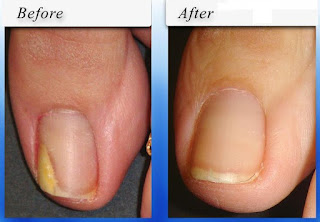Toenail fungus, also known as onychomycosis, is a common fungal infection that affects millions of people worldwide. It typically begins in the early stages, and if left untreated, it can progress and cause discomfort and pain. Understanding the early stages of toenail fungus is essential for early detection and prompt treatment to prevent further complications.
Stage 1: Discoloration of the Nail
The first sign of toenail fungus is usually a change in the color of the nail. The affected nail may appear yellow, brown, or white, and the color change may be subtle at first. It may also be accompanied by a slight thickening or distortion of the nail. Many people may mistake this discoloration for a cosmetic issue, but it can be an early indication of toenail fungus.
Stage 2: Brittleness and Crumbling
As toenail fungus progresses, the affected nail may become brittle and prone to crumbling. The nail may start to break easily, and the edges may become ragged. This can make it difficult to trim or maintain the nail properly. It may also cause discomfort or pain when walking or wearing shoes.
Stage 3: Changes in Nail Shape
In the later stages of toenail fungus, the infected nail may change in shape. It may become thicker and more distorted, and the nail bed may lift or separate from the nail plate. The affected nail may also develop an irregular or wavy surface, and debris or debris may accumulate under the nail. This can cause discomfort, pain, and an unpleasant odor.
Stage 4: Pain and Discomfort
In some cases, toenail fungus can cause pain and discomfort, especially in the later stages. The thickened and distorted nail may put pressure on the surrounding tissues, leading to pain and inflammation. Walking, standing, or wearing shoes may become uncomfortable, and the affected nail may be sensitive to touch. In severe cases, the infection may spread to the surrounding skin, causing redness, swelling, and tenderness.
Stage 5: Spreading to Other Nails
If left untreated, toenail fungus can spread to other nails, both on the same foot and the opposite foot. The fungus may also spread to the fingernails, skin, or even the groin area, leading to further infections. It is essential to be vigilant and seek prompt treatment if you suspect toenail fungus to prevent its spread and avoid more extensive complications.
Conclusion
Early detection and treatment are crucial in managing toenail fungus effectively. If you notice any discoloration, brittleness, changes in nail shape, pain, or discomfort in your toenails, it's important to seek medical attention promptly. Remember, toenail fungus is a common condition that can be easily treated in its early stages, but if left untreated, it can progress and cause discomfort, pain, and even spread to other nails or skin areas.
To prevent toenail fungus, practice good foot hygiene by keeping your feet clean and dry, wearing breathable shoes and socks, and avoiding walking barefoot in public places like communal showers or pool areas. If you notice any signs of toenail fungus, do not ignore them or try to self-treat with over-the-counter remedies, as they may not be effective in treating the infection completely. It's best to consult a healthcare professional for accurate diagnosis and appropriate treatment options.
In conclusion, being aware of the early stages of toenail fungus and taking prompt action can help prevent the infection from progressing and causing further discomfort. Remember to practice good foot hygiene and seek medical attention if you notice any changes in the color, texture, or shape of your toenails. With early detection and proper treatment, you can maintain healthy and beautiful nails. Don't let toenail fungus hold you back - take action today!




0 comments:
Post a Comment
Note: Only a member of this blog may post a comment.